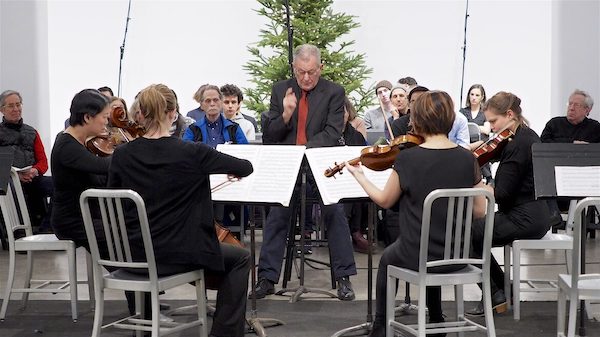S.E.M. Ensemble captures the NY moment with flow, space and silence
Despite the New York City concert situation feeling contingent once again, a seasonal tradition returned Monday night: the S.E.M. Ensemble Christmas Concert. The venue was new—the Zürcher Gallery in NoHo rather than the Paula Cooper Gallery in Chelsea—but everything else was familiar.
Most of all that meant the indefatigable Petr Kotik. The ensemble is Kotik’s baby—he cofounded it with Jan Williams and Julius Eastman in 1970—as a vehicle to perform music of the modernist avant-garde, especially that grounded in the New York School of John Cage, Morton Feldman, Christian Wolff, and Earle Brown.
Monday night, Kotik was the central figure, playing flutes on each of the five pieces, including two of his own. Or make that four, maybe. The concert culminated in an abbreviated version of his Many Many Women, and it began with something called Three-In-One, which offered three of his recent compositions (dated 2019-2021) played simultaneously.
The three pieces were Strings and Lines, played by violinist Gergana Haralampieva; Tuba Mirum for the bass trombone and percussion pair of William Lang and Josh Perry (with Perry at times picking up a trombone and contributing some scintillating multiphonic screaming); and Kotik playing No Agency on alto flute.
Kotik writes clear, straightforward material with simple rhythms often with a constant, hypnotic flow. Then, as with Three-In-One he sets of groups of music in independent simultaneity, weaving a free counterpoint and antiphony that one can follow or discard and switch between as the ear directs. Monday night, the three groups occupied aesthetically isolated spaces, with the duo playing energetic, stentorian music, Haralampieva spinning out a romantic, through-composed line, and Kotik moving along repetitive phrases with placid determination. It was like an exploded view of an apartment building, and shared the sense of city life with the street traffic passing by just beyond the gallery’s doors.
In the program notes, Kotik shared a quote from Gertrude Stein (the source for the text of Many Many Women): “Nothing changes from generation to generation, except the way of seeing things. And that makes a new composition.” That very much sums up both his own composing and the way he put together Monday night’s program—the unexpected juxtaposition of familiar means transforming language into something new.
That included three consecutive solo flute performances: Jon Gibson’s Equal Distribution No. 1, the enmeshed etudes of 6 Minute Exercises for Petr Kotik by Vladimír Šrámek and Frederick the Great’s 5 Daily Exercises, and an excerpt of the flute arrangement of Cage’s Cheap Imitation.
Gibson was an important member of the Philip Glass Ensemble and a fine composer in his own right. His piece is based around a grid system that both distributes a set of pitches and allows freedom for modulation. Played by an ensemble, that produces a series of uncanny harmonies; heard solo, it was a lovely and charming minimalist song, with Kotik’s gentle tone carrying a warm good humor.
Šrámek was a contemporary of the young Kotik at the Prague Conservatory, and encouraged the latter to start composing. His pithy exercises outline a roughly atonal system, full of broad intervals, although the music allows freedom of interpretation so the playing might have been as much Kotik exercising himself as following Šrámek. Kotik alternated between that music and that of the Prussian king, who was an avid flutist. Switching back and forth between modern and baroque flute, this was an intriguing demonstration of Stein’s terms—the emphasis was on technique, and the tonality seemed incidental to the common practice of playing the instrument well.
Again fitting with Stein, Cheap Imitation is Cage’s recreation of Satie’s Socrate, and one of his loveliest works. Especially heard through the flute and piccolo, the peacefulness of Satie’s spirit came through the sieve of Cage’s system. As much as the composer tried to separate emotional expression from writing music, he was helpless before the inherent magic of Satie’s nature.
For one who has heard Many Many Women in performance many, many times, the power of Stein as a focusing force continues to startle. Her way with words is both so firm and fluid that music written around them has a common quality—Kotik and Virgil Thomson, of all people, can seem like brothers. It comes down to the ironclad rhythms that drive words and music. In Kotik’s hands, those have weight but are not heavy— they are deliberate and move horizontally with a regularity that organizes both the four independent duos—flutes, trumpets, trombones, and sopranos Zen Wu and Elizabeth van Os—and the substantial stretches of silence between section.
A full performance can last up to six hours, Monday night’s excerpt lasted 30 minutes, enough time to build a mesmerizing quality. Although the playing was a little stiff at first, and the sopranos had a couple of awkward entrances, the musicians quickly found the steady flow the music needs, the sense of just playing and letting it all unfold however long it takes. It was like sitting amid multiple streams, feeling the water move by, occasionally dipping the hand in and out of each, in a plangent and settled feeling for unsettled times.



